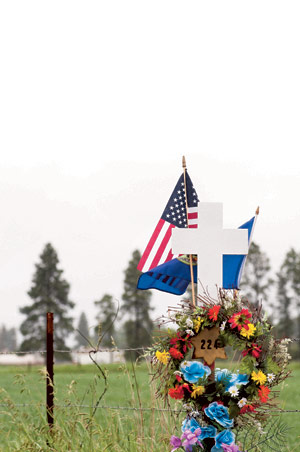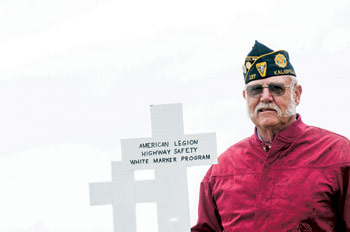For 60 years, white crosses have stood sentinel on the sides of Montana’s highways. Each steel cross is placed at the site of a road fatality; they are markers testifying to what happened there, visual reminders that life is fragile, and everything we know can change in an instant.
Each year, volunteer American Legion of Montana members mark fatal crashes across the state, viewing the work as an important part of driver safety efforts.
“They’re there to tell you the next mile ahead of you is the most important mile you’ll ever drive in your lifetime,” Lee Heser, the chairman for Montana’s White Marker Highway Fatality Program, said. “You drive defensively and you drive with care.”
Northwest Montana experienced one of the deadliest 12 days in its history this month when 12 people died on area roadways. The rash of deaths began on June 5, when Amber Morgan McAtee succumbed to injuries suffered in a rollover crash on U.S. Highway 2, west of Kalispell.
Two days later, Mercy Peterson, 18, and Kayli Mercedes Wagoner, 17, both of Columbia Falls, died after a head-on crash on U.S. Highway 2 near the Glacier Park International Airport, and on June 10, William Steven Ward, 60, of Bigfork, died after his motorcycle hit a deer on Highway 83, north of the intersection with Highway 209.
The following weekend, eight people were killed on the road. On Saturday, June 15, Debbie Caferro, 58, of Whitefish, died from injuries suffered in a crash on U.S. Highway 93 in Kalispell.
On June 16, 29-year-old Jason Hannon of Babb, 23-year-old Kyle Dodson of Browning, 23-year-old Alicia Ladd and 21-year-old Jeanette Ladd and a 17-year-old girl were killed in a rollover crash in Browning.
That same day, Jason Haugen, 32, of Troy and Kayla Marie Eberly, 21, of Libby were killed after the car they were in crashed into a pair of trees near Troy.
As of June 10, Northwest Montana had already doubled the number of road fatalities compared to the same day a year prior, according to Montana Highway Patrol.
“I couldn’t believe the number (of fatalities) in the last couple of weeks,” Montana Highway Patrol Capt. Steve Lavin said.
Driving is a privilege, inherent with its own risks and rewards and laden with laws and regulations. We teach our children with painstaking detail about the importance of seatbelts, stop signs and safe judgment; when they are teenagers, they take classes and tests to show they are capable and worthy of operating heavy machinery.
And when the summer sun warms Northwest Montana’s landscape and the pavement is clear and dry, the drivers come out in hordes. The normally sparse highways clog with cars, trucks, trailers with boats and recreational vehicles, all vying to get to their preferred spot of summer bliss.
It’s one of the best times to be in the Flathead, but it’s also one of the most lethal.
 |
|
An American Legion highway safety white marker is seen near the Trooper David Graham memorial highway sign on U.S. Highway 2 between Kalispell and Columbia Falls. – Lido Vizzutti | Flathead Beacon |
“Summertime is always a little more deadly on the highways,” Lavin said.
With the roads clear, drivers tend to push the speed limit, Lavin said, and they can get in a hurry and try to pass other vehicles more often. He urged drivers to slow down, wear their seat belts and always have a designated driver.
“People just need to be a little more careful and give themselves a little more time when traveling,” Lavin said.
Lee Heser has a farmer’s hands, deeply tanned and lined, strong and calloused from years of working outside. Last week, they gripped the steering wheel in his SUV as he drove to a few spots in Kalispell where the white crosses are planted in the ground.
A retired chief warrant officer for the U.S. Army, Heser had 30 years of service before retiring on his farm in Northeast Montana. He and his wife moved to Kalispell more than 10 years ago, and Heser helped establish American Legion Post 137 here in 2003.
Since then, he’s held every leadership position at the post, and is currently the finance officer and trustee. He became chairman of the White Marker Highway Fatality Program in 2008.
The program is unique in the United States. It began in 1953 as the brainchild of Floyd Earheart, a member of American Legion Post 27 in Missoula, after six people were killed during Labor Day weekend in 1952.
The Montana Highway Commission, now the Department of Transportation, approved the program and it gained support and participation from 90 percent of the American Legion posts throughout the state.
Some crosses stand bare, white on red poles, while others are decorated by the victim’s family and friends. Each year, Legion members clear the flowers, wreaths, statues, fishing lures, pinwheels and other personal mementos away and repaint the crosses.
“These are not memorials to the victim,” Heser said. “These are safety reminders.”
Clearing the crosses is part of an agreement the Legion has with the Department of Transportation. The 99 markers in Post 137’s area of responsibility were cleared, cleaned and repainted in May, but many have already regained the memorial tokens from family and friends.
 |
|
State White Marker Chairman Lee Heser, with American Legion Post 137, stands near a white marker already in place along U.S. Highway 2 while holding another labeled with black marker in Kalispell. – Lido Vizzutti | Flathead Beacon |
Heser believes his volunteers could make work of clearing such items every week, but they settle for once a year. The American Legion does not keep records about the markers regarding whom they are for; the available records only track location. They are located on highways, Forest Service roads and even city streets.
When the marker program first began, they were placed following a fatal crash and there was one cross per death. Now, the Legion posts typically wait until the family requests a marker, and since 2007, the transportation department only allows one marker per crash, regardless of how many fatalities occurred there.
Bob Bigler is the program chairman for Post 137, and has been since the post began in 2003. He believes the program achieves its goal in most cases, given what he’s heard from people who have talked to him about the crosses.
“The majority of people think that it’s worthwhile,” Bigler said. “(People) have commented that they’ve been driving along and all of a sudden they see one of those markers and they think, ‘Oh, I better slow down.’”
Bigler has plans to place a new white cross on Highway 2 near the airport, at the scene of the June 7 crash that killed the Columbia Falls teenagers. It’s a worthwhile program, he said, but one he wishes they didn’t need anymore.
“It’s just kind of discouraging to keep having to put them up,” Bigler said.
The Flathead’s crosses are made locally at Evergreen Welding and Grizzly Fabrication, which performs the work for free. Pacific Steel and Recycling donates the flat steel for the crosses and the posts come from the Mild Fence Company.
Some older markers have rusted out, but the new versions have powder coating and paint made to weather the years on Montana roads, which Heser said is the goal and purpose of these stark reminders.
“Once we erect a white marker, unless the highway is changed, these white markers are there into perpetuity,” Heser said.